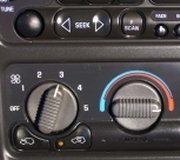It will leak anyway because of the pressure that builds up in the system. Running the heater on hot and at medium speed will make the heater core act as a small radiator. That will remove more heat and lower the system pressure. Highway driving will also help due to the air flow and cooling effect.
First of all, if the car came originally with air conditioning, there is a drain pan with a drain tube that is blocked. Look for a 4" right angle rubber hose hanging down on the passenger side of the firewall under the hood. Squeeze that tube to clear it. If nothing comes out, squeeze the wire ring that holds it on to remove it, then stick a pencil into the spout to dislodge whatever is blocking it.
Leave the radiator cap halfway off. The second catch will keep it in place but it won't seal so no pressure will build up in the cooling system. Very often sediment collects in the heater core and at first will block the corroded spot. With no pressure in the system, the coolant will not get pushed past that sediment so easily.
SPONSORED LINKS
Saturday, December 15th, 2012 AT 9:27 AM



